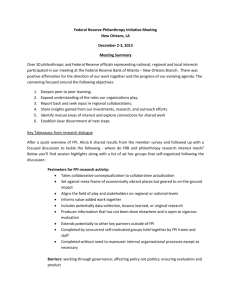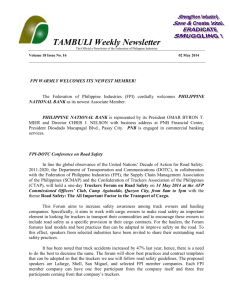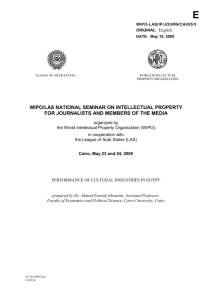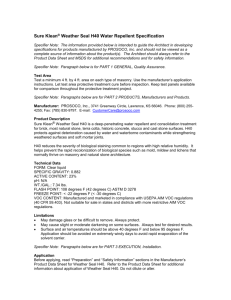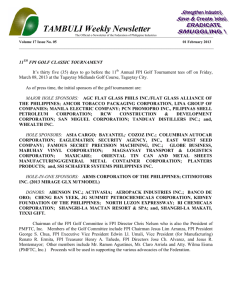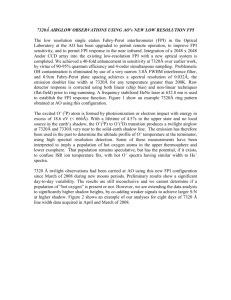Dixon’s Formula and Identities Involving Harmonic Numbers g and Mei Li
advertisement
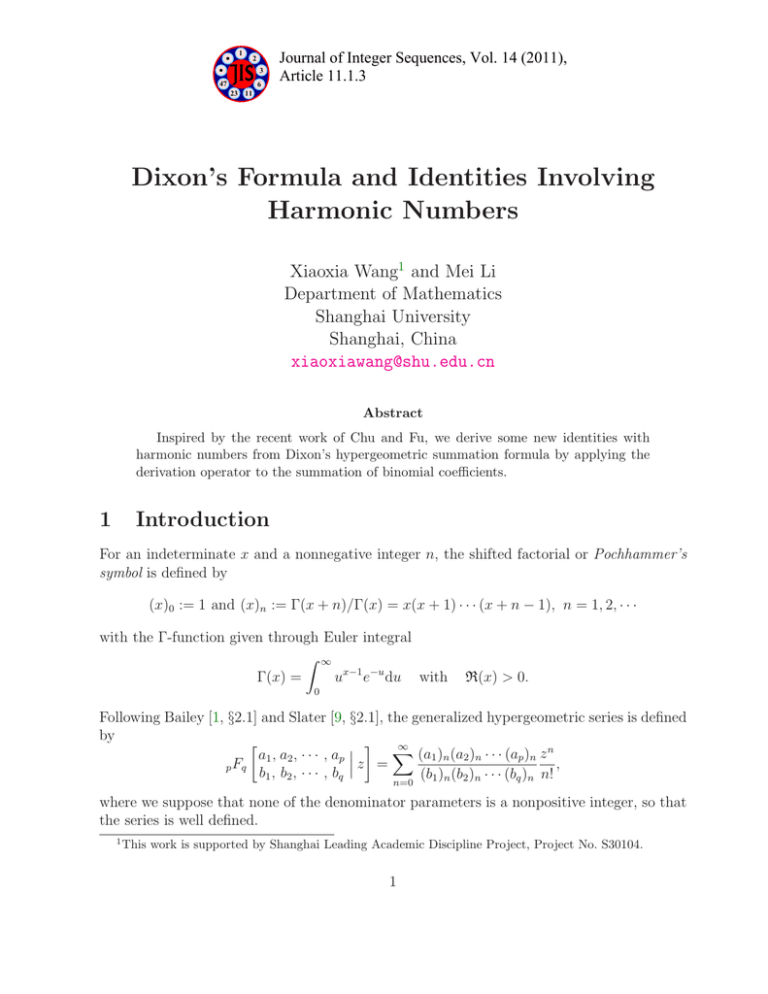
1
2
3
47
6
Journal of Integer Sequences, Vol. 14 (2011),
Article 11.1.3
23 11
Dixon’s Formula and Identities Involving
Harmonic Numbers
Xiaoxia Wang1 and Mei Li
Department of Mathematics
Shanghai University
Shanghai, China
xiaoxiawang@shu.edu.cn
Abstract
Inspired by the recent work of Chu and Fu, we derive some new identities with
harmonic numbers from Dixon’s hypergeometric summation formula by applying the
derivation operator to the summation of binomial coefficients.
1
Introduction
For an indeterminate x and a nonnegative integer n, the shifted factorial or Pochhammer’s
symbol is defined by
(x)0 := 1 and (x)n := Γ(x + n)/Γ(x) = x(x + 1) · · · (x + n − 1), n = 1, 2, · · ·
with the Γ-function given through Euler integral
Z ∞
Γ(x) =
ux−1 e−u du with
R(x) > 0.
0
Following Bailey [1, §2.1] and Slater [9, §2.1], the generalized hypergeometric series is defined
by
∞
X
(a1 )n (a2 )n · · · (ap )n z n
a1 , a 2 , · · · , a p ,
z =
p Fq
b1 , b2 , · · · , b q
(b1 )n (b2 )n · · · (bq )n n!
n=0
where we suppose that none of the denominator parameters is a nonpositive integer, so that
the series is well defined.
1
This work is supported by Shanghai Leading Academic Discipline Project, Project No. S30104.
1
The generalized harmonic numbers are defined by
Hnhℓi (x)
:=
n
X
k=1
1
(k + x)ℓ
and
Hnhℓi
:=
Hnhℓi (0)
n
X
1
=
,
ℓ
k
k=1
hℓi
H0 := 0,
with indeterminate x and natural numbers n and ℓ. When ℓ = 1, they will be abbreviated as
Hn (x) and Hn respectively. These numbers come naturally from the derivatives of binomial
coefficients
−1
−1
n+x
n+x
n+x
n+x
,
= −Hn (x)
and Dx
= Hn (x)
Dx
n
n
n
n
where the differential operator is defined as
Dx f (x) =
d
f (x),
dx
with differentiable function f (x). Obviously, the generalized harmonic numbers satisfy the
following recurrence relation
Dx Hn (x) = −Hnh2i (x) and Dx Hnhℓi (x) = −ℓHnhℓ+1i (x).
This fact can be traced back to Issac Newton [7], and has been explored recently in
several papers [2, 3, 4, 6, 8].
Chu and Fu [5] derived many identities involving harmonic numbers from Dougall–Dixon’s
4
3
summation formula. There exist nk or nk in the coefficients of identities. In recent work,
Chen and Chu [2] established a general formula involving harmonic numbers and the Riemann
zeta function. The purpose of this article is to present some new identities with harmonic
numbers from Dixon’s summation formula by applying the derivation operator to binomial
−1
3 2n
in the coefficients of the identities.
, k and 2n
coefficients. In this paper, there are 2n
k
k
2
The identities due to Dixon’s 3F2(1) summation formula
In this section, we will obtain several identities with harmonic numbers from Dixon’s summation formula. Dixon’s summation theorem is presented as follows:
Theorem 1 (Dixon [9]).
Γ(1 + 1 a)Γ(1 + a − b)Γ(1 + a − c)Γ(1 + 1 a − b − c)
a, b, c
2
2
.
1 =
3 F2
1
1
1 + a − b, 1 + a − c
Γ(1 + a)Γ(1 + 2 a − b)Γ(1 + 2 a − c)Γ(1 + a − b − c)
(I) Letting a = −2n, b = 1 + λx and c = 1 + θx in Theorem 1, we have
(2n)!(1 + λx) (1 + θx) (1 + λx + θx)
−2n, 1 + λx, 1 + θx n
n
2n+1
.
1 =
3 F2
−λx − 2n, −θx − 2n
n!(1 + λx)2n (1 + θx)2n (1 + λx + θx)n+1
2
2n+θx
, we reformulate the result
Multiplying both sides by the binomial coefficients 2n+λx
2n
2n
as the following finite summation identity.
θx+k 2n−k+λx 2n−k+θx
2n
n+λx n+θx 2n+1+λx+θx
X
(−1)k λx+k
(2n
+
1)
2n−k
k
k
n
n
2n−k
2n+1
.
(1)
=
2n
n+1+λx+θx
(n
+
1)
k
n+1
k=0
Computing the derivation of identity (1) with respect to x for one time, we get
Theorem 2.
2n
X
(−1)k
k=0
λx+k
k
θx+k
k
2n−k+λx
2n−k
2n
k
2n−k+θx
2n−k
Ω(x)
=
(2n + 1)
n+λx
n
(n +
n+θx 2n+1+λx+θx
2n+1
n
n+1+λx+θx
1)
n+1
W (x)
,
where Ω(x) and W (x) are given respectively by
Ω(x) = λH2n−k (λx) + θH2n−k (θx) + λHk (λx) + θHk (θx);
W (x) = (λ + θ)H2n+1 (λx + θx) + λHn (λx) + θHn (θx) − (λ + θ)Hn+1 (λx + θx).
Proof. The derivatives of binomial coefficients are as follows
−1
−1
n + λx
n + λx
n + λx
n + λx
.
= −λHn (λx)
and Dx
= λHn (λx)
Dx
n
n
n
n
Applying the derivation operator on the left side of the identity (1) to x, changing the
calculation of the orders of summation and derivation and simplifying the result, we have
θx+k 2n−k+λx 2n−k+θx
2n
X
(−1)k λx+k
2n−k
k
k
2n−k
2n
k=0
k
n
o
× λHk (λx) + θHk (θx) + λH2n−k (λx) + θH2n−k (θx) .
By the same method, we evaluate the derivation of the right side of identity (1) to x as
follows
n+θx 2n+1+λx+θx
(2n + 1) n+λx
n
n
2n+1
n+1+λx+θx
(n + 1)
n+1
n
o
× λHn (λx) + θHn (θx) + (λ + θ)H2n+1 (λx + θx) + (λ + θ)Hn+1 (λx + θx) .
Comparing both results, we get Theorem 2.
Setting x = 0 in Theorem 2 and noting that
Ω(0) = (λ + θ)(H2n−k + Hk );
W (0) = (λ + θ)(H2n+1 + Hn − Hn+1 ),
we have the new identity with the harmonic numbers and
3
2n −1
k
as follows:
Corollary 3.
2n
o
X
(−1)k
2n + 1 n
H
=
H
+
H
−
H
.
k
2n+1
n
n+1
2n
2(n + 1)
k
k=0
Furthermore, computing the derivation of the identity (1) with respect to x for two times,
we have another relation about the harmonic numbers.
Theorem 4.
2n
X
(−1)k
λx+k
k
k=0
=
(2n + 1)
θx+k
k
n+λx
n
2n−k+λx 2n−k+θx
{Ω2 (x) + Ω′ (x)}
2n−k
2n−k
2n
k
n+θx 2n+1+λx+θx
{W 2 (x) + W ′ (x)}
2n+1
n
,
(n + 1) n+1+λx+θx
n+1
where Ω′ (x) and W ′ (x) are given respectively by
h2i
h2i
h2i
h2i
Ω′ (x) = −λ2 H2n−k (λx) − θ2 H2n−k (θx) − λ2 Hk (λx) − θ2 Hk (θx);
h2i
h2i
W ′ (x) = −(λ + θ)2 H2n+1 (λx + θx) + (λ + θ)2 Hn+1 (λx + θx) − λ2 Hnh2i (λx) − θ2 Hnh2i (θx).
Noting further that
h2i
h2i
Ω′ (0) = −(λ2 + θ2 )(H2n−k + Hk );
h2i
h2i
W ′ (0) = (λ + θ)2 (Hn+1 − H2n+1 ) − (λ2 + θ2 )Hnh2i ,
we have the following new identity with harmonic numbers when x = 0 in Theorem 4.
Corollary 5.
2n
o
X
(−1)k n
h2i
h2i
2
2
2
2
(λ
+
θ)
(H
+
H
)
−
(λ
+
θ
)(H
+
H
)
2n−k
k
2n−k
k
2n
k=0
=
k
o
2n + 1 n
h2i
h2i
(λ + θ)2 (H2n+1 + Hn − Hn+1 )2 + (λ + θ)2 (Hn+1 − H2n+1 ) − (λ2 + θ2 )Hnh2i .
n+1
Now, we present some examples with the harmonic numbers from Corollary 5.
Example 6.
[λ = 0, θ 6= 0 or λ 6= 0, θ = 0 in Corollary 5]
2n
X
(−1)k h2i
h2i 2
(H
+
H
)
−
(H
+
H
)
2n−k
k
2n−k
k
2n
k=0
k
2n + 1 h2i
h2i
=
(H2n+1 + Hn − Hn+1 )2 + Hn+1 − H2n+1 − Hnh2i .
n+1
Example 7.
[λ = −θ 6= 0 in Corollary 5]
2n
X
(−1)k h2i
2n + 1 h2i
H .
2n Hk =
2(n + 1) n
k
k=0
4
(II) Letting a = −2n, b = λx − 2n and c = θx − 2n in Dixon’s Theorem 1, we have the
following identity
(2n)!(1 − θx − λx)3n
−2n, λx − 2n, θx − 2n .
1 =
3 F2
1 − λx, 1 − θx
n!(1 − λx)n (1 − θx)n (1 − θx − λx)2n
2n−θx
, we
Dividing both sides of the above identity by the binomial coefficients 2n−λx
2n
2n
reformulate the result as the following finite summation identity.
3
2n
n 2n 3n 3n−λx−θx
X
(−1)
(−1)k 2n
3n
k
= n−λx 2n−λx nn−θxn 2n−θx
2n−θx−λx .
(2)
k−λx k−θx 2n−k−λx 2n−k−θx
k
k
k=0
n
2n−k
2n−k
2n
n
2n
2n
When x = 0 in the above identity, we have the well known identity with binomial coefficients.
Corollary 8.
2n
X
k
(−1)
k=0
2n
k
3
n
= (−1)
2n
n
3n
.
n
Evaluating the derivation of identity (2) with respect to x for one time, we get the
following result.
Theorem 9.
2n
X
k=0
3
Ω(x)
(−1)k 2n
k
=
k−λx k−θx 2n−k−λx 2n−k−θx
k
k
2n−k
2n−k
(−1)n 2n
n
n−λx 2n−λx
n
2n
where Ω(x) and W (x) are given respectively by
3n 3n−λx−θx
W (x)
n
.
3n n−θx 2n−θx 2n−θx−λx
2n
2n
n
Ω(x) = λHk (−λx) + θHk (−θx) + λH2n−k (−λx) + θH2n−k (−θx);
W (x) = λ Hn (−λx) + H2n (−λx) + θ Hn (−θx) + H2n (−θx)
+(θ + λ) H2n (−θx − λx) − H3n (−θx − λx) .
Letting x = 0 in Theorem 9 and noting that
Ω(0) = (λ + θ)(Hk + H2n−k );
W (0) = (λ + θ)(Hn + 2H2n − H3n ),
we have the following identity.
Corollary 10.
2n
X
k=0
k
(−1)
2n
k
3
n
{Hk + H2n−k } = (−1)
2n
n
3n
{Hn + 2H2n − H3n },
n
which is a special case of Example 1 in [5]. Evaluating the derivation of identity (2) with
respect to x for two times, we obtain the identity as follows.
5
Theorem 11.
2n
X
k=0
3 2
′
2
′
n 2n 3n 3n−λx−θx
Ω(x)
+
Ω
(x)
(−1)k 2n
W
(x)
+
W
(x)
(−1)
n
.
=
k n 3n k−λx k−θx 2n−k−λx 2n−k−θx
n−λx 2n−λx n−θx 2n−θx 2n−θx−λx
k
k
2n−k
n
2n−k
n
2n
2n
2n
where Ω′ (x) and W ′ (x) are given respectively by
h2i
h2i
h2i
h2i
Ω′ (x) = λ2 Hk (−λx) + λ2 H2n−k (−λx) + θ2 Hk (−θx) + θ2 H2n−k (−θx);
h2i
h2i
W ′ (x) = λ2 Hnh2i (−λx) + H2n (−λx) + θ2 Hnh2i (−θx) + H2n (−θx)
h2i
h2i
+(θ + λ)2 H2n (−θx − λx) − H3n (−θx − λx) .
Letting x = 0 in Theorem 11 and noting that
h2i
h2i
h2i
h2i
Ω′ (0) = (λ2 + θ2 )(Hk + H2n−k );
h2i
W ′ (0) = (λ + θ)2 (H2n − H3n ) + (λ2 + θ2 )(Hnh2i + H2n ),
we derive the identity as follows.
Corollary 12.
3 n
2n
o
X
h2i
h2i
2
2
2
2
k 2n
(λ + θ) (Hk + H2n−k ) + (λ + θ )(Hk + H2n−k )
(−1)
k
k=0
n
o
3n
h2i
h2i
h2i n 2n
2
2
h2i
2
2
= (−1)
(λ + θ) (Hn + 2H2n − H3n ) + H2n − H3n + (λ + θ )(Hn + H2n ) .
n
n
This identity is the same as Theorem 2 in [5]. Now we present some examples from
Corollary 12.
Example 13.
[λ = 0, θ 6= 0 or λ 6= 0, θ = 0 in Corollary 12]
3 n
2n
o
X
h2i
h2i
2
k 2n
(Hk + H2n−k ) + Hk + H2n−k
(−1)
k
k=0
n
o
3n
h2i
h2i
n 2n
(Hn + 2H2n − H3n )2 + Hnh2i + 2H2n − H3n ,
= (−1)
n
n
which is equal to Example 3 in [5].
Example 14.
[λ = −θ 6= 0 in Corollary 12]
3
2n
o
X
(−1)n 2n 3n n h2i
h2i
h2i
k 2n
Hn + H2n .
(−1)
Hk =
2
n
n
k
k=0
[λ = 1 and θ = 1 in Corollary 12]
3 n
2n
o
X
h2i
2
k 2n
(Hk + H2n−k ) + Hk
(−1)
k
k=0
n
o
1
3n
3 h2i
h2i
n 2n
(Hn + 2H2n − H3n )2 + Hnh2i + H2n − H3n .
= (−1)
n
n
2
2
Example 15.
6
In fact, there are many identities involving harmonic numbers which can be obtained
from Corollary 12.
(III) Letting a = −2n, b = −λx − 2n and c = 1 − θx in Dixon’s Theorem refdixon, we
have the following identity.
(2n)!(λx + θx) (1 − θx)
−2n, −λx − 2n, 1 − θx n
n
.
1 =
3 F2
1 + λx, θx − 2n
n!(1 + λx)n (1 − θx)2n
2n−θx
/ 2n , we
Dividing both sides of the above identity by the binomial coefficients 2n+λx
2n
reformulate the result as the following finite summation identity.
k−θx 2n−k−θx
2n
n−θx n−1+λx+θx
X
(−1)k 2n
(λx
+
θx)
2n−k
k
n
n−1
k
=
.
(3)
k+λx 2n−k+λx
n+λx 2n+λx
n
2n−k
2n
k
n
k=0
Evaluating the derivation of identity (3) with respect to x for two times, we have the following
identity with the harmonic numbers.
Theorem 16.
2n k−θx 2n−k−θx n
o
2n−k
k
k
2
′
Ω (x) + Ω (x)
k+λx 2n−k+λx
2n−k
k
n−1+λx+θx
n
(λx + θx) n−θx
2
n−1
n
W (x)2 + W (x)
n+λx 2n+λx
x
n n
2n
2n
X
(−1)k
k=0
=
o
+ W (x) ,
′
where Ω(x), Ω′ (x), W (x) and W ′ (x) are given respectively by
Ω(x) = −θHk (−θx) − θH2n−k (−θx) − λHk (λx) − λH2n−k (λx);
h2i
h2i
h2i
h2i
Ω′ (x) = −θ2 Hk (−θx) − θ2 H2n−k (−θx) + λ2 Hk (λx) + λ2 H2n−k (λx);
W (x) = (λ + θ)Hn−1 (λx + θx) − θHn (−θx) − λHn (λx) − λH2n (λx);
h2i
h2i
W ′ (x) = λ2 H2n (λx) + λ2 Hnh2i (λx) − θ2 Hnh2i (−θx) − (λ + θ)2 Hn−1 (λx + θx).
Note that
Ω(0) = −(λ + θ)(Hk + H2n−k );
Ω′ (0) = (λ2 −
h2i
θ2 )(Hk
+
h2i
H2n−k );
W (0) = (λ + θ)(Hn−1 − Hn ) − λH2n ;
h2i
h2i
W ′ (0) = λ2 H2n + (λ2 − θ2 )Hnh2i − (λ + θ)2 Hn−1 .
the case x → 0 of Theorem 16 reads as the following new general formula.
Corollary 17.
2n
X
k=0
k
(−1)
o 2
2n n
h2i
2
=
(λ + θ)(Hk + H2n−k ) + 2(λ − θ)Hk
(λ + θ)(Hn−1 − Hn ) − λH2n .
k
n
Now we present some examples with harmonic numbers from Corollary 17.
7
Example 18.
[λ = 0 and θ = 1 in Corollary 17]
2n
X
k
(−1)
k=0
Example 19.
2n
X
o
2
2n n
h2i
2
= − 2.
(Hk + H2n−k ) − 2Hk
k
n
[λ = 1 and θ = 0 in Corollary 17]
k
(−1)
k=0
Example 20.
o 2n
o
2n n
h2i
=
(Hk + H2n−k )2 + 2Hk
Hn−1 − Hn − H2n .
n
k
[λ = 1 and θ = 1 in Corollary 17]
2n
X
1
2n
(Hk + H2n−k )2 = {2Hn−1 − 2Hn − H2n }.
(−1)
n
k
k=0
Example 21.
k
[λ = 1 and θ = −1 in Corollary 17]
2n
X
H2n
h2i
k 2n
.
Hk = −
(−1)
2n
k
k=0
Also there are many other identities can be obtained from Corollary 17. Here, we have
just presented several of them as examples.
References
[1] W. N. Bailey, Generalized Hypergeometric Series, Cambridge University Press, Cambridge, 1935.
[2] X. Chen and W. Chu, Dixon’s 3 F2 (1) and identities involving harmonic numbers and
the Riemann zeta function, Discrete Math. 310 (2010), 83–91.
[3] W. Chu, A binomial coefficient identity associated with Beukers’ conjecture on Apéry
numbers, Electr. J. Comb. 11 (2004), Paper R15.
[4] W. Chu and L. D. Donno, Hypergeometric series and harmonic number identities, Adv.
Appl. Math. 34 (2005), 123–137.
[5] W. Chu and Amy M. Fu, Dougall-Dixon formula and harmonic number identities, Ramanujan J. 18 (2009), 11–31.
[6] K. Driver, H. Prodinger, C. Schneider, and J. Weideman, Padé approximations to the
logarithm. III. Alternative methods and additional results, Ramanujan J. 12 (2006),
299–314.
[7] I. Newton, Mathematical Papers, Vol. III, Cambridge University Press, London, 1969.
8
[8] P. Paule and C. Schneider, Computer proofs of a new family of harmonic number identities, Adv. Appl. Math. 31 (2003), 359–378.
[9] L. J. Slater, Generalized Hypergeometric Functions, Cambridge University Press, Cambridge, 1966.
2010 Mathematics Subject Classification: Primary 11B65; Secondary 33C20.
Keywords: binomial coefficients, harmonic numbers, derivation, hypergeometric series.
Received July 17 2010; revised versions received December 15 2010; December 20 2010.
Published in Journal of Integer Sequences, January 4 2011.
Return to Journal of Integer Sequences home page.
9

